What we're covering:
- Decommissioning electrical fittings and equipment.
- Isolation.
- Safe decommission.
- Decommissioning Steps.
What does decommission of electrical fittings and systems mean?
Activity
Make a note of some reasons why it may be necessary to decommission electrical fittings or systems. Ask your tutor next time you are on campus.
What is Isolation? Is there a difference between switching off and isolating?
Switching off stops an electrical appliance or circuit from going or working. Isolation separates it from all possible sources of electrical energy for reasons of safety.(AS/NZS 3000 1.4.75)
If isolation is for reasons of safety, part of that safety should include making sure that the equipment cannot be re-energised accidentally so that the equipment stays safe to work on.
Activity
Importance of Safe Decommissioning
Safe decommissioning of electrical fittings and systems is crucial for protecting lives, property, the environment, and the overall integrity of electrical installations. It ensures that electrical equipment is taken out of service responsibly and in a manner that minimises risks and hazards.
Key reasons for safe decommissioning include:
Watch the following videos which emphasize the need for safety when carrying out any decommissioning activity.
- Isolating machinery when not in production
- Arc flash safety film
- How To Safely Remove a Wall Light Fitting
Isolation and Recommissioning Plan
A large-scale isolation or decommissioning project requires a plan. An isolation and recommissioning plan entails a structured approach to ensure the safe and orderly isolation and reactivation of critical plant and equipment. This comprehensive document includes:
- Specific details about the tasks at hand and the authorized personnel assigned to perform them.
- Clearly defined completion dates, along with designated timeframes, contributing to effective project management.
- A well-organised sequence for the recommissioning process, often involving the collaboration of multiple professionals and trades.
- Incorporation of manufacturers' specifications, test results, and specialised testing procedures, which are essential for compliance and accurate reporting.
The Decommissioning Process
Decommissioning simple electrical fittings and equipment involves a series of steps to ensure safety, prevent electrical hazards, and properly remove the equipment from service.
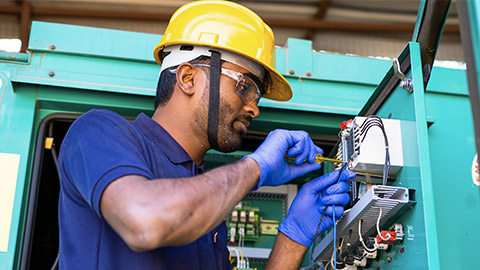
Here's a step-by-step process for safely decommissioning such items:
- Turn off the power: Before starting any work, ensure the power supply to the electrical fitting or equipment is completely turned off. This may involve switching off the circuit breaker or unplugging the equipment from the power source.
- Use proper PPE: Wear appropriate PPE, such as insulated gloves, safety goggles, and non-conductive footwear, to protect yourself from potential electrical hazards.
- Isolate from power source: If applicable, unplug the equipment from the power source. If the equipment is hardwired, isolate it by turning off the circuit breaker and locking/tagging it to prevent accidental re-energization.
- Inspect for visible damage: Carefully examine the equipment for any visible signs of damage, such as frayed cords, exposed wires, or burn marks. Do not proceed if there is damage that could pose a safety risk.
- Disconnect wires and components: If the equipment has detachable wires or components, disconnect them according to manufacturer guidelines. Take note of their positions and connections for reassembly if necessary.
- Cap or insulate wires: If there are exposed wires, cap them with wire nuts or insulate them using electrical tape to prevent accidental contact or short circuits.
- Remove batteries: for battery-operated equipment, remove the batteries and safely dispose of them according to local regulations.
- Dispose of waste properly: Dispose of any removed components, wires, or batteries in accordance with local waste disposal guidelines. Hazardous materials should be handled as directed.
- Secure or label equipment: If the equipment is being stored or transferred, secure it in a safe location or label it as "out of service" to prevent unintended use.
- Document decommissioning: Keep records of the decommissioning process, including dates, actions taken, and the responsible individuals. This documentation can be useful for future reference.
- Notify relevant parties: If required, inform relevant parties, such as maintenance personnel or supervisors, about the decommissioning to ensure proper communication and coordination.
- Follow manufacturer’s guidelines: Always follow the manufacturer's instructions for decommissioning specific equipment. Manufacturer guidelines may provide additional safety measures or recommendations.
- Re-evaluate power source: Double-check that the power source remains turned off before leaving the decommissioned equipment or area.
- Secure the area: If the decommissioned equipment will be left in place temporarily, secure the area to prevent unauthorised access and clearly mark the equipment as "not in use.”
- Final inspection: Conduct a final visual inspection of the area to ensure all necessary steps have been taken and decommissioned equipment is safe and properly secured.
Activity
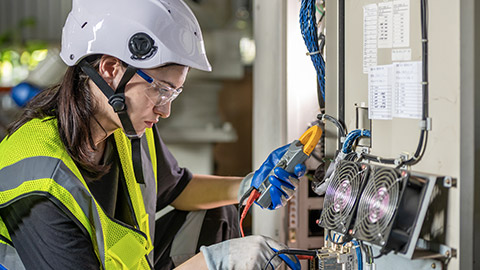
What we're covering:
- Recommissioning electrical fittings and equipment.
Let’s recap the decommissioning process before we proceed to recommissioning.
Activity
This exercise requires you to demonstrate your understanding of the procedures for disconnecting conductors at an electrical appliance or connection unit terminating points. You should describe each step of the disconnection process, including safety measures and precautions.
Instructions
Read the list of procedures for disconnecting conductors at an electrical appliance or connection unit terminating points below.
- Attaching safety tags.
- Isolation methods.
- Checking isolation (“prove – test – prove”).
- Securing isolation (lock off).
- Identification of conductors and terminals as disconnection proceeds.
- Making all exposed conductor ends safe.
- Ensuring disconnected cables are protected from mechanical damage or interference.
For each procedure provide a detailed description of the:
Recommisioning electrical fittings and equipment
After completing repairs or maintenance, it's time to recommission electrical fittings and systems. Before powering them up again, it's crucial to run safety tests to make sure they are safe, operational, and compliant with relevant regulations and standards.
When recommissioning machines and equipment, it's important to follow the testing steps recommended by the manufacturer. These tests ensure that everything works as it should. Also, the equipment needs to meet current regulations, like the electrical guidelines in AS/NZS 3000 and AS/NZS 3760 for appliances. The tests need to match the processes and expected results outlined in these standards.
Activity
Can you list ten scenarios where you might be required to recommission electrical fittings or systems?
Activity
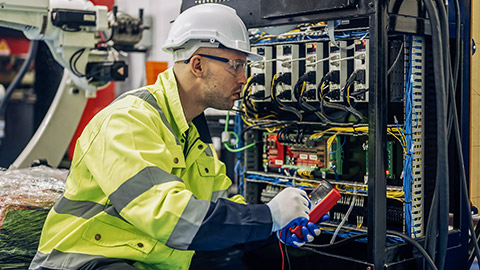
What we're covering:
- Recommissioning electrical equipment.
- Key safety checks, functional checks and restoring power.
Recommissioning electrical fittings and systems means restoring, testing, and confirming that electrical equipment, devices, and systems are in good working order. Safety is paramount during the recommissioning process due to the risks of electrocution, fire, property damage, legal compliance, and worker well-being.
Key safety checks
The key safety tests to perform before recommissioning fittings and systems include:
- Visual/Mechanical Inspection: Conduct a thorough visual inspection of the entire electrical system, including the overall mechanical state of the equipment, the proper connection of earth continuity conductors and neutral conductors to their respective bars, the completion of earth bonding for extraneous metal parts in line with AS/NZS 3000 guidelines, identification of broken components and conductor supports, and checking for loose terminations of conductors.
Additionally, the examination involves identifying stray conductor strands, burnt or damaged conductor insulation, assessing the effectiveness of flexible cord or cable anchorage, ensuring proper labelling of switches and protective devices, evaluating the condition and rating of internal fuses, overload devices, overheating devices, internal switches, and indicator lamps, and confirming the correct fitting of protective screens and guards. - Earth Continuity Test: This test ensures that the earth (ground) connection is intact and provides a low-resistance path for fault currents. It involves checking the continuity between the equipment's metallic parts and the earth connection.
To conduct the test, the exposed metal parts of the electrical equipment are checked against either the earth pin of its plug or the earth bar. The primary goal is to demonstrate an unbroken and low-resistance route to earth from any exposed metal or earth termination points. This examination is carried out with an ohmmeter set to the low ohm scale to capture very low resistance values. The connection between exposed metalwork and the earth pin of a three-pin plug should not exceed 1 ohm in resistance. Similarly, fixed wired earth continuity conductors must have a low enough resistance to trigger the protective device in the appropriate timeframe, ensuring the safety of the system. - Insulation Resistance Test: This test evaluates the soundness of the insulation within the electrical system. It involves applying a high voltage between the conductors and the ground to measure the resistance. A high resistance indicates good insulation.
For the system to pass, the insulation resistance must be equal to or greater than 1 megohm. However, before conducting these tests, it's essential to ensure satisfactory earthing. It's crucial to exercise caution when dealing with electrical systems containing semi-conductor components, as many of these components can't withstand the higher voltage of an insulation resistance tester and could break down irreparably. When testing such systems, certain precautions need to be taken, such as disconnecting semi-conductor components or testing between specific pairs and the electrical appliance framework. - Polarity and Connections Check: During the recommissioning process, ensuring correct polarity and connections is necessary to prevent potential hazards and incorrect setups.
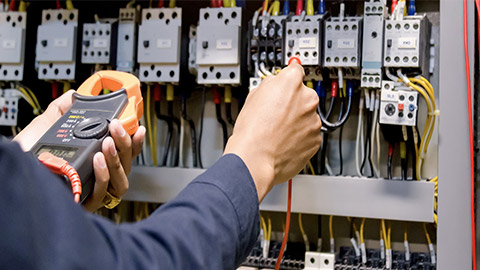
This testing involves preventing combinations like incorrect phase, neutral, and earthing conductors, connections that could electrify exposed conductive parts of the system, and incorrect connection of switches or protective devices leading to energised components when switches are off. It also covers scenarios like unpredictable operation of multi-phase equipment and semiconductor-controlled devices, current-carrying protective earthing conductors, and any short circuits. If the equipment is powered by a flexible cord, the test also includes verifying the correct polarity of cord and plug pins
Activity
Functional testing and restoring power
After finishing all the tests and confirming that the plant, equipment, or appliance is safe, the next step is to check if it works correctly.
- As each worker is done and leaves, they remove their locks and tags. This goes on until all locks are off, and then the plant can be turned back on.
- During the functional test, ensure switches, circuit breakers, and protective devices are doing their job properly. This might mean trying out some fault situations to see if the safety mechanisms react as they should.
- Double-check that circuit breakers or fuses are the right size to protect the wiring and equipment from overcurrent situations.
- Ensure that all electrical components are properly labelled and identified. This includes circuit breakers, switches, outlets, and control panels. Clear labelling helps prevent confusion and aids in emergency situations.
- If possible, energize the system in stages, checking for any abnormalities or unexpected responses before fully commissioning it.
- Review and update documentation, including schematics, diagrams, and maintenance records. Accurate documentation aids in troubleshooting and future maintenance.
- The final step is to secure certification for the plant or appliances. Appliances should be certified as safe following AS/NZS 5762 guidelines. This entails meeting the electrical test standards of AS/NZS 3760 and other requirements specified in AS/NZS 5762. For hardwired plant, it must be tested in alignment with AS/NZS 3000, and when required, a Certificate of Compliance and/or an Electrical Safety Certificate should be issued.
Activity
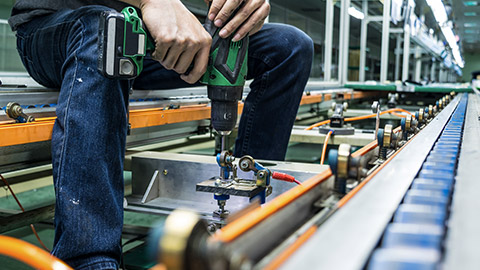
What we're covering:
- Scenario - Outline steps to decommission, then recommission a conveyor belt.
In this scenario you are an electrical technician working in a busy industrial factory that operates around the clock. Today, you have been assigned the task of decommissioning a critical conveyor belt system that transports unfinished components between different processing stations.
The conveyor belt has been experiencing intermittent issues that have affected its performance, causing delays and production losses. To address these concerns, the decision has been made to temporarily decommission the conveyor belt for thorough inspection, maintenance, and potential repairs.
Activity
For each heading below explain the steps you would take, then answer the questions following.
Questions
